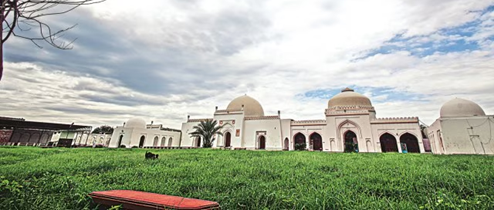Muradabad ki Pahadi | 08 Aug 2024
Why in News?
Muradabad ki Pahadi, a historical site in Delhi, has recently come into the spotlight. Named after the 14th-century Sufi saint Syed Murad Ali, this site features two mosques from different historical periods, attracting the interest of historians and locals alike.
What are the Key Facts About Muradabad ki Pahadi?
- The site features two mosques from the Tughlaq and Lodi dynasties, reflecting their distinct architectural styles.
- Tughlaq-era mosque known as Qasai Wala Gumbad.
- Lodhi-era mosque known as Shahi Masjid, features a lotus kalash.
- Syed Murad Ali's tomb is situated here, adorned with intricate arches and ornate doorways.
- The site now houses the Abdul Mannan Academy, a madarsa that serves the community and continues to preserve the site’s heritage.
Note:
- Muradabad ki Pahadi has nothing to do with the city of Moradabad, named after Prince Murad Baksh, son of Emperor Shah Jahan.
What are the Key Features of Tughlaq Architecture?
- Tughlaq architecture is known for its sturdy and solid construction. Buildings featured sloping walls, a technique known as batter, to support the increased height and loftiness of the domes.
- The Tughlaqs innovatively combined the principles of the arch, lintel, and beam in their constructions.
- Decorative items such as the water pot and lotus, derived from Hindu motifs, were incorporated into Tughlaq architecture, resulting in the Indo-Islamic style.
- Notable Tughlaq Constructions:
- Tughlaqabad: Founded by Ghiyasuddin Tughlaq, Tughlaqabad was the third city of Delhi, combining a city, fort, and palace. It marked the beginning of large-scale urban complexes.
- Ghiyasuddin Tughlaq's Tomb: This tomb introduced new architectural trends, including the use of a high platform for elevation, a white marble dome, and red sandstone for beautification. The pointed or ‘Tartar’ dome design became a hallmark of Indo-Islamic architecture.
- Jahanpanah: Built by Muhammad Bin Tughlaq, Jahanpanah was the fourth city of Delhi, emphasising the dynasty’s urban planning prowess.
- Firuzabad: Constructed by Firuz Shah Tughlaq in 1354, Firuzabad included notable structures such as Kushk-i-Firuz palace and Kotla Firuz Shah citadel. Firuz Shah also added two more storeys to the Qutub Minar and constructed Hauz Khas.
What are the Key Features of Lodi Architecture?
- The Lodis utilised both the arch and lintel-and-beam methods in their constructions, showcasing their mastery of diverse architectural principles.
- They adopted elements from Rajasthani and Gujarati architecture, including balconies, kiosks, and eaves.
- Only tombs were commissioned during the Lodi period (1451–1526) featuring hard, bare, octagonal designs about 15 metres in diameter, with a sloping verandah.
- Many Lodi tombs were set on elevated platforms and surrounded by gardens, creating a visually striking and serene environment.
- A major innovation under the Lodis was the introduction of double dome architecture. This technique involved constructing a dome with an inner and outer shell, with a distinct space between them.
- The double domes were used to strengthen the structure and reduce the dome's inner height.
- Notable Lodi Construction:
- Lodi Gardens: This expansive garden complex in Delhi is a notable example of the Lodi architectural style. It includes several significant structures.
- Tomb of Sikander Lodi: Renowned for its double dome architecture, this tomb exemplifies the innovative design of the Lodi period.
- Tomb of Mohammed Shah: Another prominent tomb in Lodi Gardens, showcasing the elevated platform design characteristic of Lodi architecture.
- Lodi Gardens: This expansive garden complex in Delhi is a notable example of the Lodi architectural style. It includes several significant structures.
UPSC Civil Services Examination, Previous Year Question (PYQ)
Q. With reference to the cultural history of India, consider the following statements: (2018)
- White marble was used in making Buland Darwaza and Khankah at Fatehpur Sikri.
- Red sandstone and marble were used in making Bara Imambara and Rumi Darwaza at Lucknow.
Which of the statements given above is/are correct?
(a) 1 only
(b) 2 only
(c) Both 1 and 2
(d) Neither 1 nor 2
Ans: (d)

